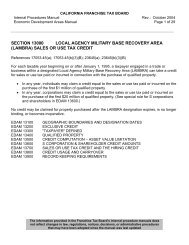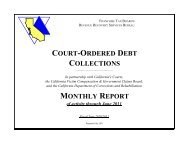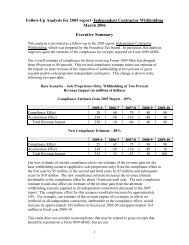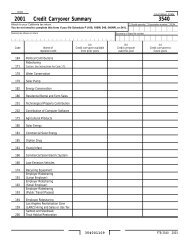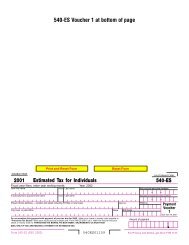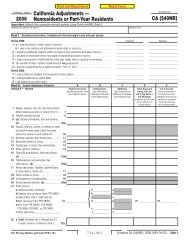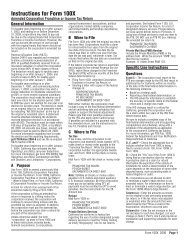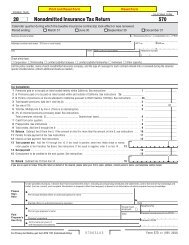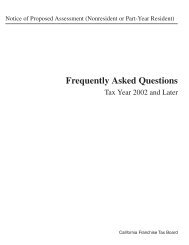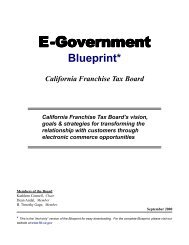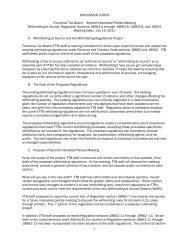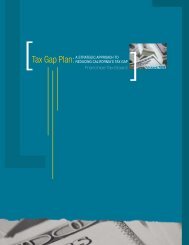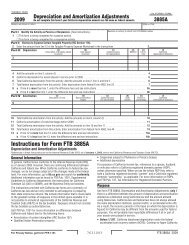Section 18662-3 - California Franchise Tax Board
Section 18662-3 - California Franchise Tax Board
Section 18662-3 - California Franchise Tax Board
You also want an ePaper? Increase the reach of your titles
YUMPU automatically turns print PDFs into web optimized ePapers that Google loves.
Regulation section <strong>18662</strong>-3 is amended to read:<br />
§ <strong>18662</strong>-3. Amount to Be Withheld Real Estate Withholding.<br />
(a) General.The amount of tax to be withheld shall be computed by applying a rate of<br />
7%, or such lesser rate as authorized in writing by the <strong>Franchise</strong> <strong>Tax</strong> <strong>Board</strong>.<br />
Withholding at source is required on proceeds from the sale or exchange of <strong>California</strong><br />
real estate by resident individuals and by nonresident individuals and business entities<br />
without a permanent place of business in <strong>California</strong>. The rate of withholding is 3 1/3% of<br />
the sales price, but the seller may elect an alternate rate based on the gain required to<br />
be recognized from the sale. The requirement to withhold is the responsibility of the<br />
buyer, but is generally performed by the Real Estate Escrow Person on the buyer's<br />
behalf. No withholding is required if certain exceptions are certified, notably that the<br />
property was the seller's principal residence or that no gain will be recognized from the<br />
sale. The <strong>Franchise</strong> <strong>Tax</strong> <strong>Board</strong> may audit escrow documents to verify compliance.<br />
(b) Statutory Basis and Rates.<br />
At the request of either the payer or payee, the <strong>Franchise</strong> <strong>Tax</strong> <strong>Board</strong> may consider<br />
documentation to the effect that the 7% rate will result in overwithholding. After<br />
considering such documentation, the <strong>Franchise</strong> <strong>Tax</strong> <strong>Board</strong> may waive the withholding<br />
requirements, in whole or in part, or authorize the use of a lower withholding rate. As a<br />
further condition for waiver or for authorizing a lower withholding rate, the payee will be<br />
required to assure the <strong>Franchise</strong> <strong>Tax</strong> <strong>Board</strong>, by bond, deposit or otherwise, that the<br />
source income withholding requirements applicable to the payee as a payor will be<br />
complied with.Revenue and <strong>Tax</strong>ation Code section <strong>18662</strong>, subdivision (e), requires<br />
withholding at source from any disposition of <strong>California</strong> real property at an amount equal<br />
to 3 1/3 percent of the sales price of the <strong>California</strong> real property conveyed, unless an<br />
election is made to use an alternative withholding rate based on gain from the sale.<br />
(c) Who Must Withhold – Required Notification and Responsibility<br />
The <strong>Franchise</strong> <strong>Tax</strong> <strong>Board</strong>'s waivers and Notices to Withhold reflecting a withholding rate<br />
less than 7% shall be in writing and shall be mailed to the payor. If the payor has<br />
already withhold prior to the receipt of a waiver or Notice to Withhold, the payor may<br />
make a payment to the payee of the amount of overwithholding, if any.<br />
(1) Notification. Revenue and <strong>Tax</strong>ation Code section 18668, subdivision (e)(1),<br />
requires the real estate escrow person to provide written notice about the<br />
withholding requirements, unless the buyer is an intermediary or accommodator in<br />
a deferred exchange.<br />
(2) Failure to Provide Notification. If the real estate escrow person fails to<br />
provide required written notification, a penalty may be imposed of $500 or 10% of<br />
the amount required to be withheld, whichever is more, unless it is shown that the<br />
failure to notify is due to reasonable cause.
(3) Buyer's Responsibility to Withhold May be Delegated. Once the buyer is<br />
notified, it is the buyer’s responsibility to withhold. However, the real estate escrow<br />
person may assist the buyer to comply with the withholding requirements by<br />
performing or arranging for the withholding and remittance of required withholding<br />
and may charge a fee for this assistance not to exceed the amount set forth in<br />
subdivision (e) of section <strong>18662</strong>.<br />
(d) Exemptions From Withholding. No withholding is required if the seller establishes<br />
that one of the following exemptions applies:<br />
(1) Total Sales Price of $100,000 or Less. No withholding is required unless the<br />
sales price of the property conveyed exceeds $100,000. "Total sales price" is<br />
generally the same amount as required for information reporting purposes and<br />
shown on the federal form 1099-S. (See Treasury Regulation section 1.6045-4.)<br />
(2) Seller Certifies That it is a <strong>California</strong> Business Entity. Withholding is required<br />
unless the seller certifies that it is a <strong>California</strong> business entity as defined in<br />
Regulation section <strong>18662</strong>-2, and that it will continue to have a permanent place of<br />
business within <strong>California</strong> after the sale, or is a bank or a bank operating as a<br />
fiduciary for a trust, a tax-exempt entity, or an insurance company, individual<br />
retirement account (IRA), qualified pension plan, or charitable remainder trust.<br />
(3) Exempt, Disregarded and Other Entities.<br />
(A) <strong>Tax</strong>-Exempt Entities. Withholding is not required if the seller is a tax<br />
exempt entity under <strong>California</strong> or federal law (e.g. government agency,<br />
Resolution Trust Corporation, or exempt, charitable, religious, or educational<br />
organizations.)<br />
(B) Insurance Companies. No withholding is required if the seller certifies<br />
that it is an insurance company subject to the gross premiums tax under<br />
<strong>Section</strong> 28 of Article XIII of the <strong>California</strong> Constitution.<br />
(C) Disregarded Entities. Eligible business entities with a single owner, such<br />
as a single member limited liability company, that is disregarded for federal<br />
and <strong>California</strong> income tax purposes are also disregarded for withholding<br />
purposes. The owner of the disregarded entity is considered to be the seller<br />
and title to the property is considered to be in the name of the single member<br />
for withholding purposes.<br />
(D) Trusts. If a trust is a "grantor" trust, it is ignored for tax purposes and the<br />
seller for withholding purposes is the grantor. Usually the grantor of a grantor<br />
trust is an individual. All withholding forms should be completed using the<br />
individual’s (grantor’s) information. If the trust is other than a grantor trust<br />
(e.g. an "inter vivos" or "living" trust), then the seller is the trust. All
withholding forms should be completed using the name of the trust and the<br />
trust’s federal employer identification number (FEIN).<br />
(E) Real Estate Investment Trusts (REIT). For real estate withholding<br />
purposes, a REIT is treated as a corporation. Withholding is not required as<br />
long as the REIT has a permanent place of business in <strong>California</strong>.<br />
(F) Bankruptcy Trusts and Estates. Withholding is required when a<br />
bankruptcy trust or estate sells the property. There are no exemptions for<br />
trusts with a <strong>California</strong> trustee.<br />
(G) Estates. Withholding is generally required when an estate sells real<br />
property. However, if the property being sold qualified as the decedent’s<br />
principal residence, withholding is not required.<br />
(H) Conservatorships. Withholding is required unless the conservatee<br />
qualifies for an exemption. The conservator should complete real estate<br />
withholding exemption certificate using the conservatee’s information.<br />
(4) Principal Residence. No withholding is required if the seller certifies that the<br />
property conveyed was their principal residence within the meaning of Internal<br />
Revenue Code section 121, as incorporated by and modified by the <strong>California</strong><br />
Revenue and <strong>Tax</strong>ation Code or that the last use of the property was as the<br />
transferor's principal residence. Generally, a home will qualify as a principal<br />
residence if, during the five-year period ending on the date of sale, the seller or<br />
sellers have owned and lived in the property as their main home for at least two<br />
years. There are exceptions to the two-year rule if the primary reason they are<br />
selling the home is due to a change in the place of employment, health, or other<br />
unforeseen circumstance such as death, divorce, or loss of job. See Internal<br />
Revenue Code section 121 and Treasury Regulation sections 1.121-1 through<br />
1.121-5. Even if the property does not qualify for exclusion under Internal Revenue<br />
Code section 121, the seller may still claim the exclusion from withholding if the<br />
property was last used as the seller's principal residence within the meaning of<br />
Internal Revenue Code section 121, without regard to the two-year time period.<br />
Where <strong>California</strong> law differs from federal law, due to changes made to federal law<br />
after the specified incorporation date in the Revenue and <strong>Tax</strong>ation Code, or<br />
specific modifications under section 17152, the <strong>California</strong> provisions will apply.<br />
The <strong>Franchise</strong> <strong>Tax</strong> <strong>Board</strong> shall explain these differences in annual publications,<br />
forms and instructions.<br />
(5) Loss or Zero Gain. If the seller has either a loss or zero gain for <strong>California</strong><br />
income tax purposes from the sale, which results when the seller's adjusted basis<br />
in the property is more than or equal to the selling price (less selling expenses),<br />
then no withholding is required. It is not a loss or zero gain just because there are<br />
no proceeds from the sale or because the property is selling for less than it is<br />
worth. In computing gain under this exemption, sellers may use passive activity
losses that directly relate to the property being sold. They may not use losses that<br />
are not directly related to the property, such as passive activity losses or<br />
carryforwards from a different property, capital loss carryforwards, stock losses, or<br />
net operating losses.<br />
(6) Involuntary Conversions. Withholding is not required when sellers certify that<br />
the transfer is the result of an involuntary transfer under Internal Revenue Code<br />
section 1033 and that they intend to replace the property with qualified property<br />
within the required time period under Internal Revenue Code section 1033.<br />
(7) Contributed Capital - Transfers to a Controlled Corporation or Partnership.<br />
Withholding is not required where the transferors certify that the transfer qualifies<br />
for nonrecognition treatment under Internal Revenue Code section 351 (property<br />
transferred to a corporation controlled by the transferor) or Internal Revenue Code<br />
section 721 (property contributed to a partnership in exchange for a partnership<br />
interest).<br />
(8) IRC <strong>Section</strong> 1031 Exchanges. No withholding is required on the initial<br />
transfer where the seller certifies that the transfer will qualify as:<br />
(A) A Simultaneous Like-Kind Exchange. However, if the seller receives any<br />
proceeds from the sale (boot), withholding is required at 3 1/3% of that<br />
amount or the alternative withholding amount, if so elected.<br />
(B) A Deferred Like-Kind Exchange. However, if the seller receives<br />
proceeds from the sale (boot) in excess of $1,500, withholding is required at 3<br />
1/3% of that amount or the alternative withholding amount, if so elected.<br />
(C) Failed Transactions. Notwithstanding the certification above, if the<br />
transaction fails, does not occur or does not meet the Internal Revenue Code<br />
section 1031 requirements, the intermediary or accommodator must withhold<br />
at 3 1/3% of the full sales price amount or the alternative withholding amount,<br />
if so elected.<br />
(9) Foreclosure. To be excluded from withholding as part of a foreclosure, the<br />
transferee must be acquiring the property under one of the following<br />
circumstances:<br />
(A) At a sale pursuant to a power of sale under a mortgage or deed of trust.<br />
(B) At a sale pursuant to a decree of foreclosure.<br />
(C) By a deed in lieu of foreclosure.<br />
(10) Relocation Companies. Sales to relocation companies are subject to the<br />
same rules as other sales. There is no withholding on the sale if the relocating<br />
seller certifies that the property was their principal residence or if they qualify for
any other exemption. Otherwise, withholding is required. Relocation companies<br />
themselves are subject to the same rules as other non-individuals.<br />
Example 1. A relocation company resells the property to a third party. There is no<br />
withholding on the sale if the relocation company meets an exemption. If the<br />
relocation company does not meet an exemption, withholding is required.<br />
Example 2. An employer that is treated as owner of the real property under federal<br />
law gives a relocation company power of attorney to act on its behalf in the resale<br />
of property to a third party. No withholding is required on the sale if the employer<br />
certifies that it has a permanent place of business in <strong>California</strong>. If the employer<br />
does not have a permanent place of business in <strong>California</strong>, withholding is required.<br />
The relocation company is not subject to real estate withholding because it is only<br />
acting as an agent for the seller.<br />
(e) Exemption, Installment Sale and Alternate Withholding Rate Procedure<br />
(1) Exemption Certificate and Estimated Gain or Loss Certificate. The seller<br />
must complete a real estate withholding exemption certificate prior to the close of<br />
the real estate transaction to claim exemption from withholding. Failure to provide<br />
a completed and signed real estate withholding exemption certificate by the close<br />
of the real estate transaction will result in withholding. If the exemption is claimed<br />
due to loss or zero gain, the seller must also complete and sign a real estate<br />
withholding – computation of estimated gain or loss form.<br />
(2) Filing and Retention of Exemption Certificate. The <strong>Franchise</strong> <strong>Tax</strong> <strong>Board</strong> may<br />
specify by forms and instructions whether the exemption certificate and/or the<br />
estimated gain or loss certificate must be filed with the <strong>Franchise</strong> <strong>Tax</strong> <strong>Board</strong>, or<br />
simply retained by the real estate escrow person for submission, upon request, at<br />
a later date to the <strong>Franchise</strong> <strong>Tax</strong> <strong>Board</strong>. If required to be filed immediately, the<br />
<strong>Franchise</strong> <strong>Tax</strong> <strong>Board</strong> may specify the conditions for filing and the due date of such<br />
filing. Whether or not the certificate is required to be filed with the <strong>Franchise</strong> <strong>Tax</strong><br />
<strong>Board</strong>, the real estate escrow person must retain the form for five years following<br />
the closing date of the transaction.<br />
(3) Verification. Real estate escrow persons are only required to verify<br />
certifications to the extent that they have actual knowledge of the facts. If they<br />
have no actual knowledge of the facts, then they must only verify that the<br />
certificate is complete and signed. The real estate escrow person will be relieved<br />
of the withholding requirements if they rely in good faith on a completed and signed<br />
real estate withholding exemption certificate. Real estate escrow persons may not<br />
rely upon an incomplete or unsigned certificate.<br />
Example 1: A seller completes a worksheet calculating the estimated gain or loss<br />
and certifies a loss on the transaction. The <strong>Franchise</strong> <strong>Tax</strong> <strong>Board</strong> does not require<br />
the real estate escrow person to verify the amounts shown on the worksheet.
Example 2: A seller completes a real estate withholding exemption certificate and<br />
certifies that the sale is an installment sale. However, the buyer has not provided a<br />
completed and signed installment sale agreement to the real estate escrow<br />
person. The real estate escrow person may not rely the real estate withholding<br />
exemption certificate and is required to withhold on this transaction.<br />
Example 3: A seller completes a real estate withholding exemption certificate and<br />
certifies that a partnership is selling the property, but the real estate escrow person<br />
has actual knowledge that the recorded title of the property is not in the name of<br />
the partnership. The real estate escrow person may not rely on the real estate<br />
withholding exemption certificate and is required towithhold on this transaction.<br />
(4) Electing the Alternate Withholding Rate. The seller making the election must<br />
complete and sign a real estate withholding – computation of estimated gain or<br />
loss form, and sign a completed Real Estate Withholding <strong>Tax</strong> Statement. The<br />
signature certifies in writing under penalty of perjury the gain required to be<br />
recognized and the alternate withholding amount. The <strong>Franchise</strong> <strong>Tax</strong> <strong>Board</strong> may<br />
specify by forms and instructions whether the forms must be filed with the<br />
<strong>Franchise</strong> <strong>Tax</strong> <strong>Board</strong>, or simply retained by the real estate escrow person for<br />
submission, upon request, at a later date to the <strong>Franchise</strong> <strong>Tax</strong> <strong>Board</strong>. If required<br />
to be filed immediately, the <strong>Franchise</strong> <strong>Tax</strong> <strong>Board</strong> may specify the conditions for<br />
filing and the due date of such filing. Whether or not the election is required to be<br />
filed with the <strong>Franchise</strong> <strong>Tax</strong> <strong>Board</strong>, the seller and the real estate escrow person<br />
must retain the form for five years following the closing date of the transaction.<br />
(5) Installment Sales. The real estate escrow person must withhold the full 3 1/3<br />
% of the total sale price or the alternative withholding amount when escrow closes,<br />
unless the buyer agrees to withhold on the principal portion of each installment<br />
payment. To withhold on the principal portion of each installment payment, the<br />
buyer must complete and sign a real estate withholding installment sale<br />
agreement. The buyer must give this form to the real estate escrow person. Based<br />
on the buyer’s written agreement with the <strong>Franchise</strong> <strong>Tax</strong> <strong>Board</strong>, the real estate<br />
escrow person will then withhold either 3 1/3 percent of the first installment or an<br />
alternative withholding percentage of the first installment. If the buyer does not<br />
elect to withhold on each installment payment, either 31/3 percent of the total sales<br />
price or the alternative withholding amount certified by the seller must be withheld<br />
at the time of the sale.<br />
(f) Special Rules.<br />
(1) Multiple Family Units. If the property sold is a multiple family unit (duplex,<br />
triplex, apartment building, etc.) and the seller lived in one of the units as their<br />
principal residence, withholding is required only for the portion of the sales price<br />
that is not for the principal residence. The sales price should be allocated between
the principal residence and the remainder of the units using the same method that<br />
the seller used to determine depreciation deductions for the non-principal<br />
residence portion of the property. Withholding is still required when the total sales<br />
price of the property (all units) exceeds $100,000, even if the portion of the sales<br />
price allocable to the non-principal residence portion of the property does not<br />
exceed $100,000.<br />
(2) Multiple Sellers/Parcels. When there are multiple sellers, the withholding<br />
amount is calculated by applying the withholding rate to each seller’s proportionate<br />
share of the total sale proceeds.<br />
Example 1: Withholding at 3 1/3% of total sale proceeds<br />
Total sale proceeds $200,000<br />
Sellers’ ownership percentages:<br />
A = 20%, B = 30%, C = 50%<br />
Withholding per seller:<br />
A $200,000 x 20% x .0333 = $1,332<br />
B 200,000 x 30% x .0333 = 1,998<br />
C 200,000 x 50% x .0333 = 3,330<br />
Example 2: Alternative withholding method, assuming a maximum tax rate of 9.3%<br />
in the year of sale:<br />
Gain on sale $200,000<br />
Seller’s ownership percentages:<br />
A = 20%, B = 30%, C = 50%<br />
Withholding for individual seller:<br />
A $200,000 x 20% x .093 = $3,720<br />
B 200,000 x 30% x .093 = 5,580<br />
C 200,000 x 50% x .093 = 9,300<br />
(3) Sellers on Title for Incidental Purposes. If the incidental sellers have no<br />
financial ownership, then their ownership percentage is zero and there is no<br />
withholding required for them.<br />
Examples of sellers who are on title for incidental purposes are:<br />
Example 1: Father is on title only because he cosigned to help daughter qualify for<br />
a loan. If father completes a real estate withholding exemption certificate showing<br />
zero percentage of ownership, no withholding is required on father. Daughter is<br />
the beneficial owner of the property and is subject to the normal withholding<br />
requirements.<br />
Example 2: Son is on title only to receive property upon mother’s death. If son<br />
completes a real estate withholding exemption certificate showing zero percentage
of ownership, no withholding is required on son. Mother the beneficial owner of the<br />
property and is subject to the normal withholding requirements.<br />
(4) Sale of Multiple Parcels When the Total Sale Price of all Properties Exceeds<br />
$100,000, but the Sale Price of Each Separate Parcel is Under $100,000. Sales of<br />
multiple parcels within the same escrow agreement constitute one transaction for<br />
purposes of determining the withholding requirements under this regulation.<br />
(5) Leaseholds/Options. The sale of a leasehold is considered a sale of a real<br />
property interest, so withholding is required. The sale of an option to buy real<br />
property is also considered a sale of a real property interest, so withholding is<br />
required.<br />
(6) Personal Property Included in Real Estate Transaction. If personal property<br />
is included in the sales price of the real property, withholding is computed on the<br />
full amount. If the price of the personal property is stated separately in the sales<br />
contract, the withholding base does not include the personal property amount.<br />
(7) "Cash-Poor" Transactions. The fact that a transaction is cash-poor does not<br />
provide an exemption from withholding, and the parties must arrange to pay the<br />
withholding that is due. When a tax lien is recorded on the property, the proceeds<br />
in the escrow account are first used to pay the required withholding before the<br />
proceeds may be used to satisfy an existing lien, including federal tax liens. If there<br />
are insufficient proceeds available to pay off a federal tax lien and the withholding<br />
amount that is due, then the parties can arrange to pay the withholding amount<br />
outside of escrow.<br />
Note: Authority cited: <strong>Section</strong> 19503, Revenue and <strong>Tax</strong>ation Code.<br />
Reference cited: <strong>Section</strong> <strong>18662</strong>, Revenue and <strong>Tax</strong>ation Code.



